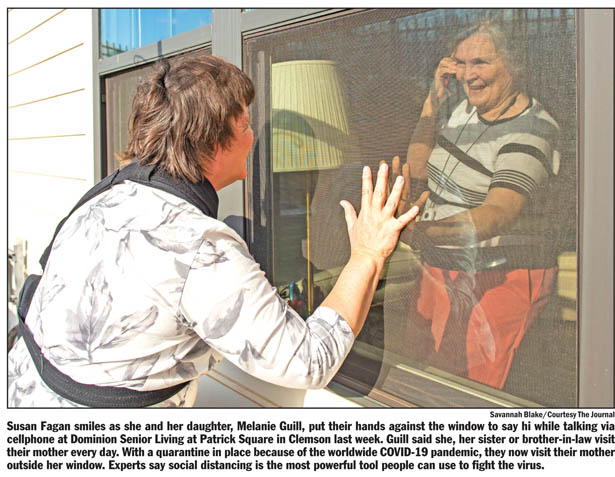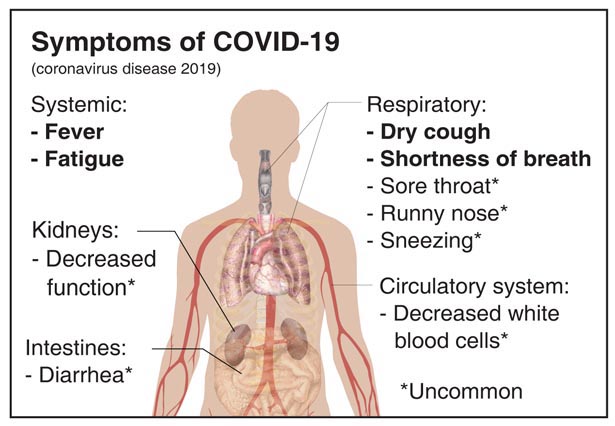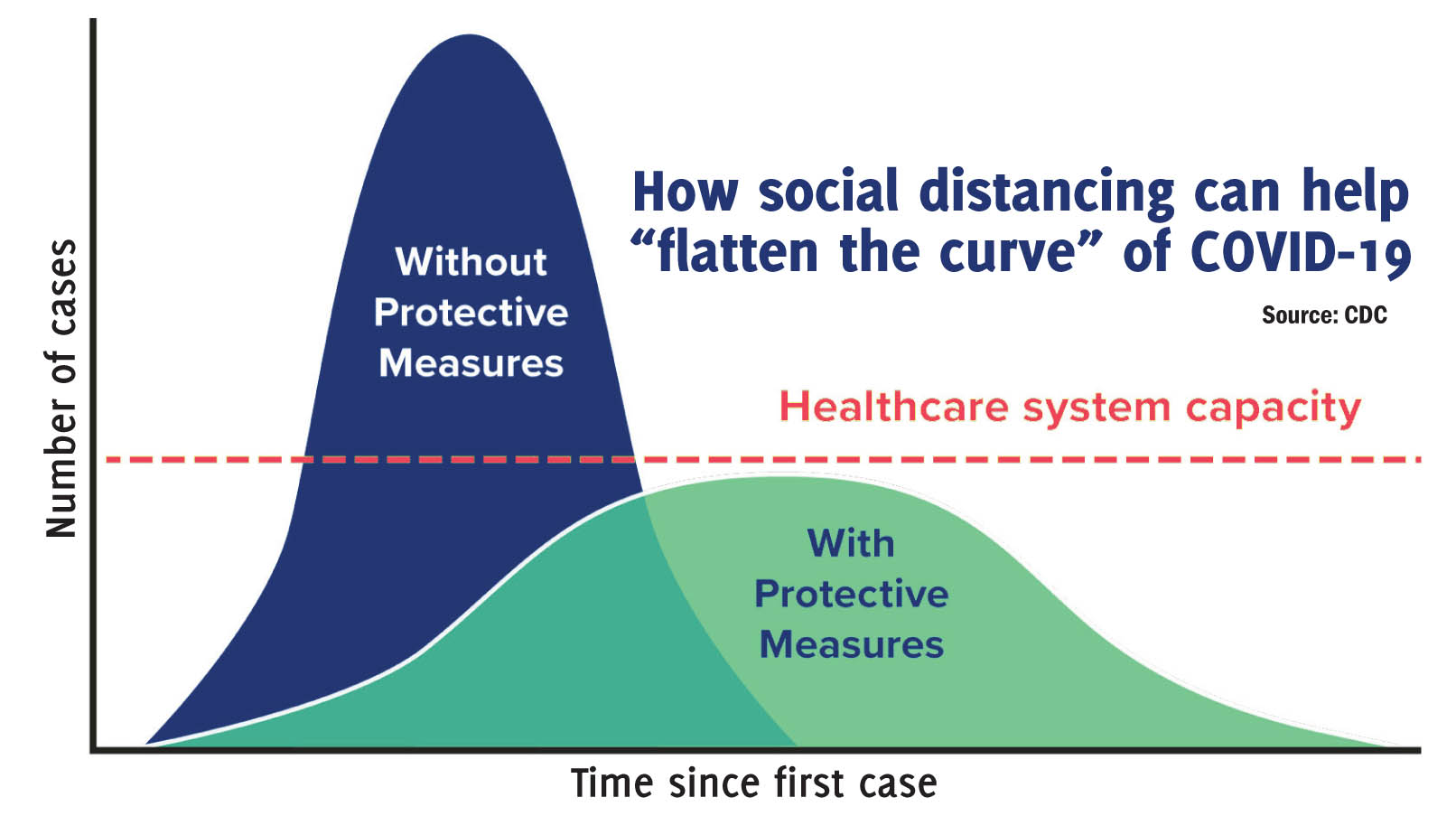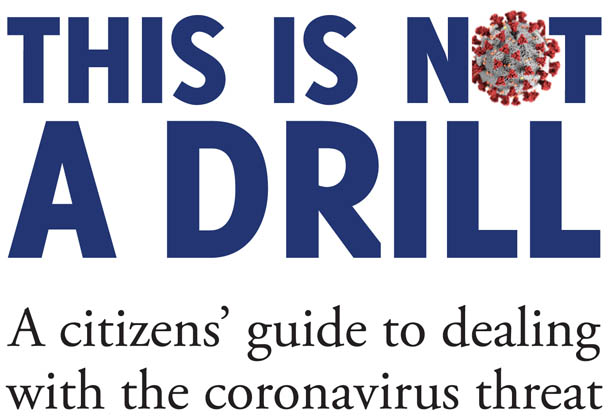This is not a drill

There is plenty of doom and gloom about the coronavirus out there, so how about a little good news for a change? The good news is there is something that actually works. It’s not a cure-all drug, a vaccine (which is at best a year away) or some snake oil concoction you can buy on the internet. It’s  called social distancing, and it is easier and more effective than you might think.
called social distancing, and it is easier and more effective than you might think.
Let’s look first at what social distancing is and what it is not. It is not locking yourself up in the house for some undetermined length of time. You can go outside and take a walk around the neighborhood. You can sit on the porch and watch the squirrels and the birds and your neighbors as they pass by. You can drive to a park, stroll a well-worn path and commune with nature. You can go to the store to get groceries, or to the gas station to fill up the car, or to the drug store to get your medicines, or to big box stores to replenish your supply of all those things essential to life.
You can go outside and take a walk around the neighborhood. You can sit on the porch and watch the squirrels and the birds and your neighbors as they pass by. You can drive to a park, stroll a well-worn path and commune with nature. You can go to the store to get groceries, or to the gas station to fill up the car, or to the drug store to get your medicines, or to big box stores to replenish your supply of all those things essential to life.
The term social distancing actually refers to two things. First, it does indeed mean spending most of your time at home, but you can avoid cabin fever or just plain old boredom by venturing out from time to time. More about how to safely do that later on. The other aspect of social distancing is maintaining a safe distance of six to eight feet between you and other people at all times and in all places.
Your goal in social distancing should be to make your home your safe space, the one place where you can be reasonably certain that you will not come in contact with the coronavirus. To make that happen, you will have to do something that goes against our natural instinct, the very fiber of our being. Humans are social creatures, and here in the South, we are some of the friendliest, most hospitable and gracious people on the planet. Our southern hospitality is legendary. Lord knows I love the South and thank the good Lord every day that I grew up where I did, and that I was raised the way I was.
 Regardless of where you are from or how you were raised, in order to create your safe space, in order to protect yourself, you are going to have to make sure that someone does not bring the coronavirus into your sanctuary. This means that you should not invite or allow anyone, other than those who live with you, into your home. These are extraordinary and perilous times, and one day we will get back to our normal, wonderfully mundane daily lives, but for now, you need to do what you need to do.
Regardless of where you are from or how you were raised, in order to create your safe space, in order to protect yourself, you are going to have to make sure that someone does not bring the coronavirus into your sanctuary. This means that you should not invite or allow anyone, other than those who live with you, into your home. These are extraordinary and perilous times, and one day we will get back to our normal, wonderfully mundane daily lives, but for now, you need to do what you need to do.
So hunkering down at home is not the worst thing in the world, and alternatively, for folks like me who are 65 years old or older, and are in the high-risk group, it is literally a strategy that could save your life. Plus, right now it is optional. I fully expect that we are very near the point where that will not be the case. Several states have already imposed mandatory “stay at home” orders, and it is reasonable to expect that it will eventually happen here. And I cannot emphasize this too much — social distancing is the only way to stem the tide of this still-evolving pandemic. Social distancing, however, is only effective if everyone — or at least a majority of people — do it.
By the way, you may have heard that only older folks are at risk of serious complications, even death, from the coronavirus. It was initially called the 20/80 rule; that is, the 20 percent of our older population (basically 65 and older and especially those with underlying health conditions) would be the only ones to have serious, life-threatening symptoms, and the 80 percent of people younger than 65 would only experience mild to moderate symptoms, and young folks in their teens and 20s may experience no symptoms at all or nothing worse than something like a cold or the flu. Let me state this as clearly as I can — that paradigm is no longer true.
To be sure, the early indications were that the above statements were in fact true, but as we obtained more detailed reports from around the world, (especially from Italy), and based on our own experience in areas like Seattle and New York City, we now know that all age groups are vulnerable, and as many as 53 percent of all cases in New York were 18-49 years old. Children as young as 1 year old have contracted the virus and required hospitalization, and teenagers and 20-somethings are now known to comprise a significant number of hospitalizations for complications from coronavirus. One 7-month-old infant in Camden contracted the virus and is now being treated. In short, no one is immune from coronavirus.
The single most pernicious and most devastating aspect of this novel virus is the fact that people of all ages who have contracted the virus, but initially have no symptoms, can infect other people through direct contact. This is the reason it has spread like wildfire around the globe and in this country. People who don’t have a clue they have been infected are out there carrying on with their daily lives and have no idea that they are spreading it around. This is why social distancing is the key. We have to prevent or significantly limit person-to-person spread and we have to take affirmative steps to protect those most vulnerable. Social distancing checks all the boxes. It accomplishes all those things that we as a nation need to do and need to do right now.
I don’t want to scare anyone, but the reality is that we are in the very early stages of a global pandemic that is going to play out over the next several months or longer — possibly much longer. For a while, the news is going to get worse each day. We have not reached the peak yet, but it is not far off, and the numbers of infected persons and deaths among our fellow citizens is going to frighten everyone. Social distancing is absolutely and without qualification the single best, most powerful tool we have to slow the spread of this horrible pandemic. It is in your own best interest to do it, and we all have an obligation to do what we can to help all those front-line health care workers and first responders stay healthy and do their jobs.
If you reflexively put your right hand over your heart and pledge allegiance to the American flag every time you hear the national anthem, this is your chance to prove that you mean what you say when you pledge allegiance to the red, white and blue, and to “the republic for which it stands.” Your country needs you right now. It needs you to do the right thing by helping reduce the impact of this ongoing threat to our collective health and well-being. Folks did it during the Great Depression, they did it during World War II, and they did it when our country was attacked on 9/11. I am confident that we will once again step up to the challenge, do the right thing, and make the sacrifices that will be required of us in the coming weeks and months. Now is the time for all good men and women, young and old, regardless of race, creed, political affiliation, skin color or sexual orientation, to come to the aid of their country.
Hunkering down or sheltering in place is doable and the right thing to do, but you will eventually need to venture outside your safe space to get groceries, medicine or to seek solace in the woods and wild places, and et cetera. Let’s look at what you can do to minimize the risk those kinds of activities can bring.
Under the heading of “Know Your Enemy,” it is important to understand just exactly what you are up against. The coronavirus, which is so small that it cannot be seen with a microscope, is actually only one of a class of viruses of the corona type. It was originally referred to as “novel coronavirus” because it is new, never before seen by scientists anywhere in the world. This new virus (specifically designated COVID-19) originated in bats in the wilds of Wuhan Province, China. Bats are considered food in China, and apparently infected bats were sold in fresh markets in Wuhan. That’s when it made the leap to humans, and from that point on it was Katie bar the door, and the rest is history.
Here’s the good news. The coronavirus has at least two vulnerabilities. Its Achilles heel is that it cannot survive very long outside the cells of a host, and maybe even more importantly, it is easily killed or deactivated by agents that you almost certainly already have in your home. Seventy percent isopropyl alcohol will do it. Hydrogen peroxide will do it. A weak solution of common household bleach will do it, and you can mix it yourself. Formulas for mixing these disinfectants can be found at numerous websites online.
So how do you stay safe when you venture out? Let’s use a trip to the grocery store as an example, since that is something everyone will need to do. My wife, Jane, and I have developed a protocol that we follow religiously. We keep hand sanitizer gel in the car, and Jane has a small squeeze bottle that attaches to her pocketbook. We also keep a pump bottle of liquid soap in the car. Before we get out of the car, we spread a thin layer of the liquid hand soap all over our hands. This is something that I have come up with myself, which I believe adds an extra layer of protection. Then we take a hand sanitizer wipe with us in our dominant hand. This is for opening doors, or handling the spout at the gas pump or anything else that requires you to touch something. If the store provides sani-wipes at the door, use one to wipe down the push handle on the cart and keep it with you case you need it; for example, when you open the glass doors on the coolers with the frozen foods.
Before I describe what you will have to deal with once inside the store, consider the only two routes that the coronavirus is known to get inside your body. As far as we know right now, the primary means by which you can become infected is if you happen to be standing very near someone who is infected and is actively coughing or sneezing. This creates a cloud of vapor that contains the virus and consists of two types of elements. The first are the heavier droplets that very quickly fall to the floor or on some horizontal surface. The other components are finer mists (aerosols) that linger in the air somewhat longer. Early research indicates that, with the notable exceptions of small spaces like offices, and in clinical situations such as a hospital room, aerosols are not a major source of contamination. It’s the heavier droplets that cause the problem, and that problem only lasts for a short period of time. This is why you need to maintain a safe distance of six to eight feet from everyone at all times and everywhere you go. Due to the fact that most large grocery stores have huge air handlers that keep the ambient air in circulation and are constantly bringing in fresh air, the fine aerosols from sneezing and coughing are probably not the primary problem.
One of the most important habits you can develop is to try to refrain from touching your face. I say, “try to refrain from” because it is hard. Research has shown that we unconsciously touch our face about 20 times an hour. It’s a hard habit to break, but hand-to-face contact is a serious risk factor. Remember, as far as we know, the coronavirus is most likely to enter your body through your mouth or your nose. Sometimes when it is important, even old dogs can learn new tricks.
Another category of risk is coming into contact with hard surfaces and product packaging that you must necessarily touch in order to shop. Pay no attention to that for right now. If you choose to use the liquid soap strategy that I use, you have a layer of protection between your skin and those surfaces.
Finally, there is a final risk at the checkout. Obviously, if someone in line or the caashier is sniffling or sneezing, or wiping their nose, go to another line. If you pay with a credit or debit card and you insert the card itself, no problem. If the store requires that the clerk swipe the card, wipe it off with the sanitizer cloth that you have in your hand. If you pay in cash and receive change, you don’t need to do anything at the register.
Now, when you get back to the car, assume that despite your best efforts, you came in contact with the virus. Once in the car, wipe your hands down with hand sanitizer, and I wipe down both the steering wheel and the gear shifter.
Then when you get home; carry in the groceries, then wash your hands with soap and water for at least 20 seconds, which is longer than you think. This is where the layer of liquid soap comes into play. Any virus that you bring home with you is trapped in a layer between the liquid soap you applied before entering the store and the gel hand sanitizer you applied in the car. When you wash your hands at this point, the liquid soap will, of course, also wash away, and your hands should be clean enough do surgery. I am kidding, of course, but you will have done everything you could reasonably do to keep the virus out of your home.
There is the possibility that the packaging that comes along with your groceries or whatever else you brought home has residual virus on it. We go ahead at this point after washing our hands and put up the groceries and then wash our hands again and happily go on about our way.
There are several studies that proclaim to have documented how long the coronavirus can survive or persist on various surfaces. I am not going to quote those studies because they have widely differing times, and I know for a fact that survivability of a virus is dependent on the nature of the surface, the ambient temperature and humidity and whether or not the surface has been wiped off with a disinfectant of some sort. It’s a situation where there is more variability in the equation than there is certainty. Generally, the coronavirus appears to persist on paper and cardboard for about 24 hours, on plastics and metals for up to 72 hours, and somewhat longer periods on stainless steel. Take that for what it is worth. I have seen one research article that claims that it can survive on some surfaces for as much as nine days. I doubt that is the case, but it was in a widely respected scientific journal. Assume that any surface you come in contact with in a public place is contaminated with coronavirus and you will be good to go.
I know all this sounds paranoid, but this is serious business. If you become infected with coronavirus, all bets are off and you face an uncertain future. Again, I don’t want to frighten anyone, so I will simply state what I know to be a fact.
If you become infected with the coronavirus, depending on when and where you live, and your age and underlying health status, you could die or could have relatively mild symptoms. If your situation progresses to the point that you are having trouble breathing, you need to contact your doctor or a hospital emergency room. Follow their advice. Just be advised that as this pandemic accelerates, our medical support system is extremely vulnerable to becoming overwhelmed and you may be left with nothing more than your own immune system to determine your fate.
Everyone needs to understand that there is no cure for the coronavirus. Even if you can get a hospital bed, the main thing is that what they can do for you is very limited, mostly to provide palliative care, which means making you comfortable. In general, if your symptoms have progressed to the point that you are having serious problems breathing problems by the time you get to the hospital, you almost certainly have developed pneumonia and the only thing they can do is put you on the extremely limited number of ventilators available. Ventilators can only buy some time for your own immune system to overcome this novel virus, to which you have no natural immunity. To be blunt, the prognosis is not good. This is serious business.
All of which reinforces the importance of all the measures I have outlined to keep from becoming infected. Just keep in mind that you are not alone. This is a country of 320 million people, and we are all in this together.
Also keep in mind that this too shall pass. There will be a time when we get back to something we can call normal. There will be a time when blue skies prevail, birds sing their glorious, cheerful songs and there will be a big ol’ rainbow stretching from Sassafras to Myrtle Beach. But for now, I was always taught that the Lord helps them who help themselves. We are being tested, and I am confident that we will roll up our sleeves, bite the bullet and do what we must to save ourselves and our friends, family and neighbors and do what we must to defeat this evil, invisible enemy. As Barney Fife used to say, we need to “Nip it, nip it in the bud.” Stay safe and stay well and pray for our country.




























